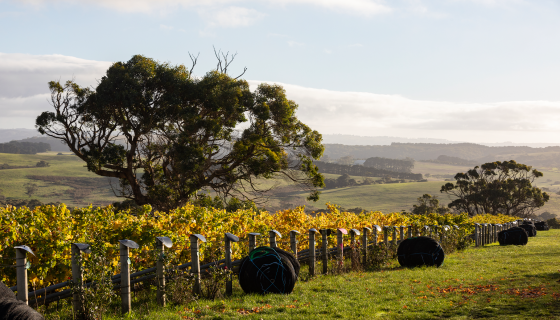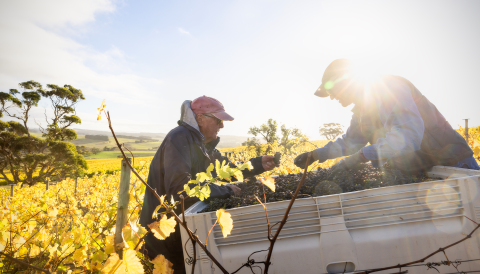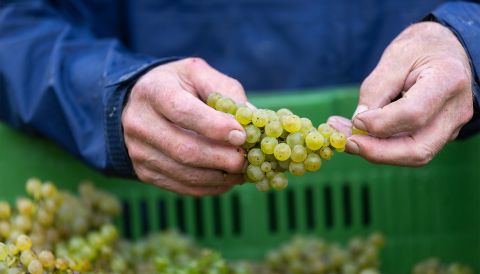It is 18 April, a gloriously typical autumn day in the Adelaide Hills.
It is as if the Piccadilly Valley is a painted autumn landscape. Everything is so still, not even a quivering leaf, the autumn green-gold of the vineyards signalling their year’s work is done. The frenetic activities of harvest finalised a vintage year of high anxiety. The vineyards are saying leave us alone, let us rest before the winter takes over and the cycle begins again.
We finished harvesting Foggy Hill yesterday, the last of our three vineyards to be harvested. Perversely, it is usually the first.
On 11 April I made the decision to harvest the Tiers Chardonnay, before the expected rain on the weekend of the 15th. The expected materialised, as 40 mm (1.6 in) of rain in two short bursts that the Pinot Noir fruit hanging on the vines in Foggy Hill had to endure before it was harvested yesterday.
It endured heroically, with no detriment to the fruit.
The Tiers Chardonnay was harvested before the rain, on 13 April, and we had to sort out about 1% of the bunches from the picking bins because of the incipient botrytis infection, a function of Chardonnay’s thinner, more fragile berry skins, the very late harvest and the consistently moist conditions of mid autumn.
Had the Chardonnay been left on the vine over the wet weekend, the level of botrytis would have likely ballooned, to the extent it would have changed the taste of the wine, partially masking the native terroir flavours and aroma of the Tiers Chardonnay. Those Piccadilly Valley Chardonnay attributes are why we are here, growing grapes in this fickle environment.
I have already commented on the serial disasters of Australia’s inland grape-growers. Many were destined to leave their grapes on the vine courtesy of the punitive Chinese import duties on Australian wine and the decimation of that market. Many of the many have been spared that heart-rending decision because Mother Nature has taken the lot, through vineyard inundation and rain-induced disease.
Theirs is a hard game, servicing the branded commodity wine market, selling bulk grapes at a settled low price, their only opportunities to increase miserly profit through higher productivity or cutting costs. They are true agriculturalists, valuing their on-farm independence and growing grapes for profit. Many will probably depart the industry over the next few years.
Ironically the expected very low 2023 national crop, just two-thirds of normal at 1.2 million tonnes, may well bring the Australian wine inventory back into balance with sales, instantly drying up the surplus. If, as is mooted, the Chinese reverse their punitive levies and if Australia can win back some of its previous market share, then there will potentially be a large structural shortage of Australian grapes and wine. A lot of ifs and potentially a very different result.
The cooler coastal vineyards of Australia, including our three distinguished sites, have also suffered diminished yields. I have not interrogated the vintage region by region, but our vineyards in the Piccadilly Valley (Adelaide Hills), the Southern Fleurieu Peninsula and Wrattonbully are all down on average yields by half. The 2023 vintage has produced very expensive grapes from full vineyard expenses and half the crop.
The crops are down in our vineyards because of the very cool and windy spring flowering season, a function of our dominant weather system, SAM (Southern Annular Modulation). SAM’s cold south-easterly winds blowing through our vineyards at flowering inhibited fruit set and diminished the final crop.
The quality of the small, late crop of Chardonnay from Tiers; Cabernet Sauvignon, Merlot and Cabernet Franc from the Whalebone; and finally the Pinot Noir from Foggy Hill is all very high – higher than I anticipated and much higher than what I had feared. The low crop level and impact on profitability will be addressed only much later. The primary concern of cool-climate vignerons at harvest is monomaniacally focused on the quality of the crop and the implicit quality and style of the wine produced.
In 2023 we have high natural acids and intense fruit flavours in our Tiers Chardonnay juice, the same in our Pinot Noir and Cabernet musts, along with vibrant colours and grown-up tannins as we begin the fermentations.
It is a moment of huge relief to have it all in the winery, sound and very promising. What we do from here is almost mundane, as we shepherd the native fruit quality of the vineyard terroir through the winemaking process, losing nothing of the vibrancy and intensity of his unique 2023 vintage.
In the end, cool-climate vignerons are not gamblers, although we are sometimes forced to make contingent picking decisions based on weather. Always we have to accept what Mother Nature delivers and make the most of it. We are optimists, always hoping this next vintage will be the very best of all, knowing it will, at the least, be different from all the preceding others in unexpected ways.
The 2023 vintage in our three distinguished-site vineyards perfectly answered the description of unexpected and unique.

















